Parametric estimation is a crucial estimation technique in project management.
That’s because parametric estimations are highly accurate and take some guesswork from your estimation process.
Things you’ll learn about parametric estimations in this article:
- Pros and cons
- Use cases
- Real-life examples
- How to do parametric estimating
- How Toggl Track can help you create accurate estimates
- And more!
What is parametric estimating?
Parametric estimating is a statistical technique that estimates project costs, durations, and resources.
As the name suggests, this technique identifies the relation between cost or time value and a project parameter and then scales it up for the entire project.
For example, if it takes four hours to create a webpage, it’ll take 40 hours to build a 10-page website.
The more granular the parameter, the more accurate the estimate.
For example, creating a webpage involves designing graphics, writing copy, and coding. The amount of work involved would differ for each type of page. If a project manager can identify the parameters for each activity, they can estimate the duration even more accurately.
That’s why, unlike analogous estimation, parametric estimation is considered a bottom-up estimation technique.
This technique provides a more accurate estimate and works best after the project scope is finalized.
Parametric estimating formula
Different statistical ways to calculate estimates based on your project needs and historical data exist.
A straightforward formula for parametric estimating is:

In this formula:
- E_parametric = parametric estimate
- a_old = historic amount of time or cost
- p_old = historical value of the parameter
- p_curr = value of that parameter in your current project
The success of the formula depends on using excellent, up-to-date information.
What’s an example of parametric estimating?
How does parametric estimating work in real life?
Let’s look at a practical example of using the parametric estimating technique.
Imagine you run a marketing agency.
You’ve just secured a contract to produce a series of promotional videos. You’ve done similar projects before and need to calculate costs for this new task.
Here’s where parametric estimating comes into play.
From your previous projects, you know that each minute (p_old) of a promotional video costs around $1,000 (a_old). This cost includes scripting, shooting, editing, and final touches. Now, your client wants a series of five 3-minute videos (p_curr).
You can use parametric estimating to calculate the overall cost.
According to the above formula, your numbers are:
p_old = 1 minute of video production
a_old = $1000
p_curr = 5 x 3-minute videos
E_parametric = (a_old/p_old) x p_curr
= ($1000/1)x(5x3)
= $15000This estimation method gives you a quick, reliable estimate based on actual data from your past projects, not just a ballpark figure.
You can give your client a realistic quote, plan your budget accurately, and create a profitable project.
What’s the difference between parametric and analogous estimating?
Analogous estimating is a top-down estimating technique that relies on historical data and actual experience to estimate project costs and durations.
The differences between parametric and analogous estimating are many.
One main difference is how they use historical data to estimate project costs and durations.
Let’s have a closer look at these differences.
- Accuracy: Parametric estimating is more accurate for similar tasks. Like bottom-up estimating, parametric estimating works best when projects have the same repetitive tasks.
Analogous estimating is faster but less accurate. It saves time but sometimes gives you the wrong forecast, especially for new or complex projects.
- Data usage: Parametric estimating relies on math and past data. It uses old projects to make detailed calculations for the new ones.
Analogous estimating relies on data and experience. It’s quick and not as accurate.
- Level of detail: Parametric estimating is more granular. It looks at tasks and activities of similar past projects to create estimates.
Analogous estimating looks at the whole picture. It uses experience and information from an entire past project to estimate the time and costs for a new one.
When should I use parametric estimating?
When is parametric estimating the right tool for the job?
Here’s how to know.
When you have historical data available
If your shelves are full of records from past projects, that’s your cue.
This wealth of historical data is gold. You can use it to forecast future project costs and durations more accurately and confidently.
One thing to remember here is that the higher the quality of your data, the more accurate your current estimates are.
When you can quantify your parameters
Are your projects easily measurable? Can you break them into repetitive tasks and correlate them with time and costs?
If yes, parametric estimating is the correct technique as it thrives on quantifiable information.
You can set solid benchmarks if you’re clear about past project metrics. This clarity gives you more reliable, precise estimates for new projects.
When you need to make an accurate estimation
Parametric estimations give you accurate, reliable predictions of how much time and money you need for a project.
How to do parametric estimating
Here are four practical steps you can implement in your parametric estimating process.
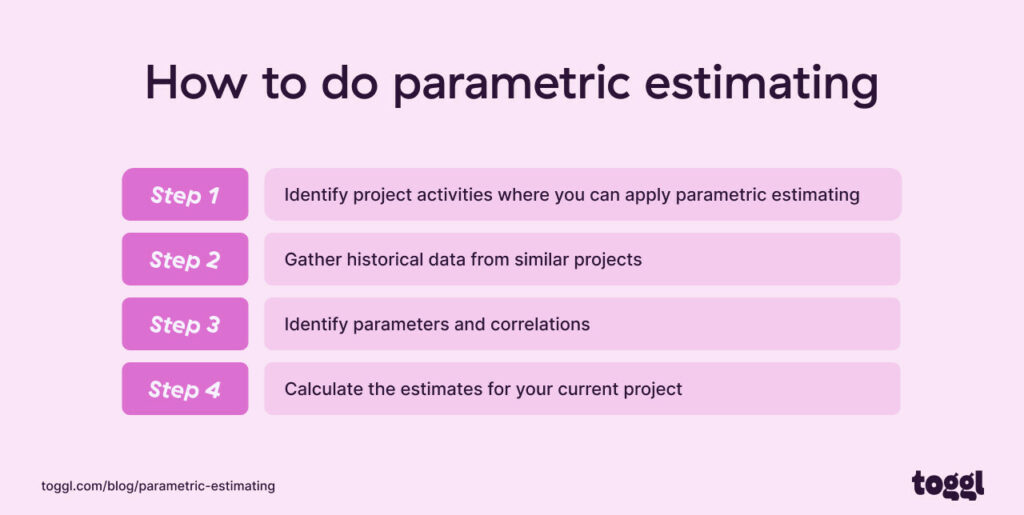
Step #1: Identify project activities where you can apply parametric estimating
Start by breaking down your project into phases and activities. You can use a work breakdown structure to do that easily.
Key questions to ask at this point:
- What type of estimate do you need? Rough or detailed?
- How do project parameters connect to time or cost?
- Can you access historical data for your estimations?
Step #2: Gather historical data from similar projects
Next, you need to look for data from past projects similar to the new one.
Search for the actual hours spent on tasks, the real costs, and the genuine outcomes. What did you quote for creating a logo last year? How long did it take to code that email template?
Find these numbers and ensure they’re from projects similar to the current project.
With Toggl Track, you can quickly see how much past projects cost and how long they took.
Access historical data (estimated, actual, and estimated vs actual) in Toggl Track by going to Projects on the left sidebar.

Get a clear overview of past projects’ costs and durations and create more accurate estimates.

You can also visualize a project forecast to better understand the estimates and project risks.
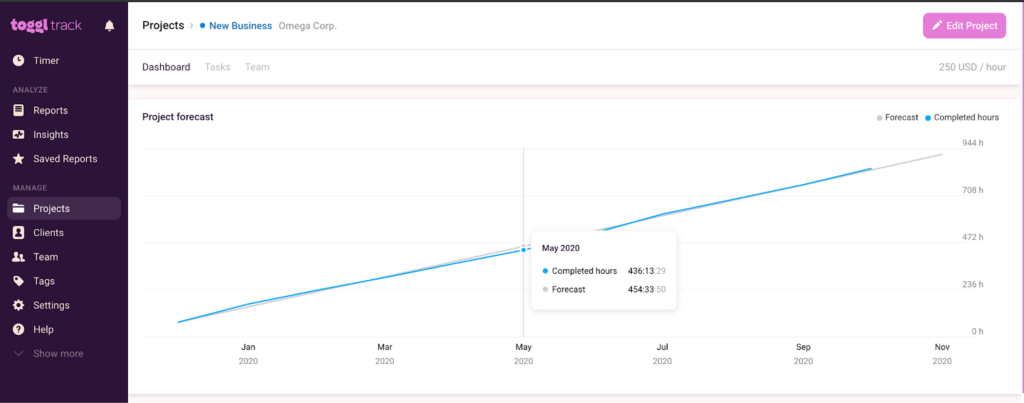
Step #3: Identify parameters and correlations
You now have your data, but how does it all connect?
You can identify parameters and correlations by:
- Spot repetitive tasks in the current project
- Identify similar tasks in the historic project
- If each of the historic tasks has a similar timeline and cost, you can make the task a parameter
- If not, dig in deeper to find more specific tasks
Step #4: Calculate the estimates for your current project
You’re now ready to do the math and create your estimates.
Here’s the parametric estimating formula once again:
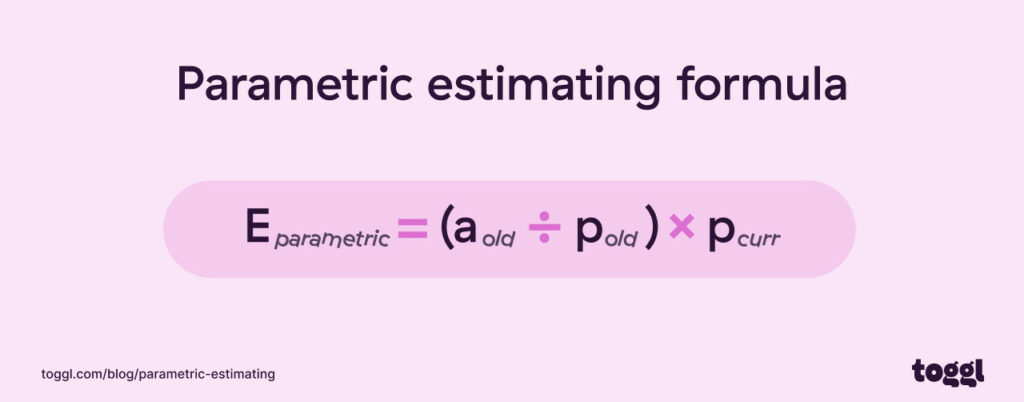
Where:
- E_parametric = parametric estimate
- a_old = historic amount of time or cost
- p_old = historical value of the parameter
- p_curr = value of that parameter in your current project
How is parametric estimating used for large and complex projects?
If done right, parametric estimating can help you estimate even large and complex projects.
Let’s look closer at how parametric estimating works on a larger scale.
For larger projects, you may need to create multiple statistical models for different project parameters.
Once you’ve identified the parameters and created estimation models, it’s time to validate them to ensure they are realistic.
This is where back-testing comes in. Back-testing gives your model a reality check and catches estimation errors. During back-testing, you compare your estimates with historical estimates to determine the accuracy of your model.
For example, imagine you run a marketing agency. You used parametric estimating to create a prediction model for your social media campaign costs.
To back-test this model, you use data from similar previous campaigns.
If your model predicts $5000 for a particular campaign setup, which historically cost $7000, your model is inaccurate.
What are the advantages and disadvantages of parametric estimating?
Like any estimation technique, parametric estimating has both strengths and weaknesses.

Let’s look closer at each of them.
Advantages of parametric estimating
The key advantages of parametric estimating are the following:
- Accurate: Reliable data from the past means reliable predictions for the future. Parametric estimating uses historical data to make sure new estimates are spot-on. You can use this method to catch patterns you can apply to your current work.
- Reusable: Parametric estimating helps you avoid the slow step-by-step planning that starts from scratch. Because it uses information from past projects, you don’t have to build every estimate from the ground up. You find what’s similar, use those details, and get results fast. This way, you have more time for other critical tasks.
- Works in different project stages: Parametric estimating isn’t just for the start of a project. It’s a tool you can use at many points. Early on, it helps give a clear picture of what resources you need. Later, if things change, you can adjust your plans using the same reliable method.
- Builds credibility: When your estimates are accurate repeatedly, people take notice. They start to trust you and your team’s predictions. This trust leads to smoother approvals, less second-guessing from stakeholders, and a stronger negotiation position.
Disadvantages of parametric estimating
The key disadvantages of parametric estimating are the following:
- Needs good data: Parametric estimating relies heavily on past data. Your estimates won’t be accurate if that data is wrong or outdated. You need the correct information from the start, or your plans could lead you off course.
- Time-consuming: Finding the correct data and ensuring it fits your project means checking everything carefully. This whole process can slow things down, especially at the start of a project.
- Not always flexible: Parametric estimating often assumes projects are very similar. But each project is unique. When projects step outside the usual, this method might not work well. Parametric estimating doesn’t always bend to fit new situations, which can lead to mistakes in planning.
How can project managers improve the accuracy of parametric estimates?
Here are some tips for ensuring your parametric estimates are spot on.
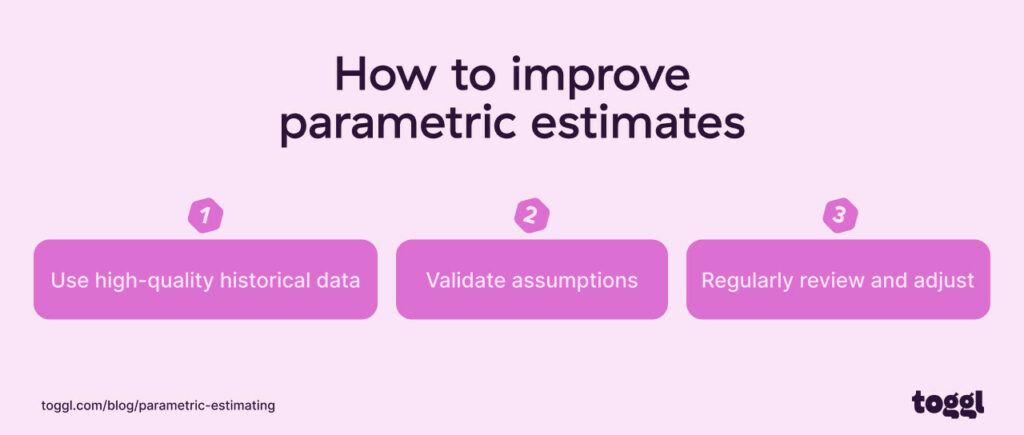
Use high-quality historical data
The first step is all about gathering the data from past projects.
And this data isn’t just numbers. It should also include details about what worked or didn’t while identifying the risks and bottlenecks encountered in the project.
The better your data, the more accurate your estimate.
Validate assumptions
Next up is double-checking the project’s basics. Are you sure that what happened in the past will happen again? You need to confirm these assumptions at the start of the project.
Experienced team members can help you validate your assumptions to ensure you’re not missing anything.
Regularly review and adjust
Project planning isn’t set in stone. It’s a living thing that can change when new information comes in.
So, keep an eye on your project. When things shift, adjust your plans to keep everything accurate and realistic.
Adjusting could mean reallocating resources, timelines, or project objectives.
Create better estimates with the right tool
No matter your project estimation technique, having quality historical data improves your estimates.
You can get that data by tracking time spent on projects and tasks.
With Toggl Track, keeping track of your team’s work hours is easy and seamless.
With just a few clicks, you record time, generate time reports, and access historical data to create better estimates. Sign up for Toggl Track and give it a try.
Work tools to elevate your productivity – apps for incredibly simple time tracking and effective project planning.
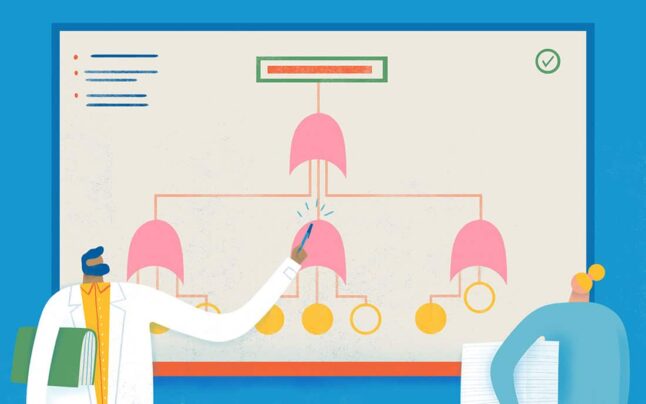
![9 Best Timeline Apps for 2023 [With Ratings, Features & Pricing]](images/timeline-software-work-646x404.jpg)
